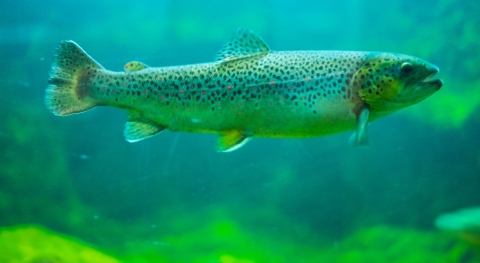
Mitchell Fleming soutiendra sa thèse de doctorat intitulée :
« Environmental and neuroendocrine control of smoltification in long-river (Loire-Allier) Atlantic salmon, Salmo salar »
Jeudi 20 décembre 2018 à 14h00
Lieu : Amphithéâtre de la Galerie de Paléontologie, Jardin des Plantes, Muséum National d'Histoire Naturelle, Paris
Devant le jury :
- Mme. Catherine Pasqualini (rapporteur), CR CNRS, Gif-sur-Yvette, France
- M. Ian Mayer (rapporteur), PR NMBU, Oslo, Norway
- M. Gilles Boeuf (examinateur), PR SU, Paris, France
- M. Laurent Sachs (examinateur), DR CNRS, Paris, France
- M. Patrick Martin (examinateur), Dir CNSS, Chanteuges, France
- Mme. Karine Rousseau (co-directrice de thèse), MC MNHN, Paris, France
- Mme. Sylvie Dufour (directrice de thèse), DR CNRS, Paris, France
Résumé : Contrôle environnemental et neuroendocrine de la smoltification chez le saumon Atlantique, Salmo salar, de longue rivière
La smoltification est un évènement métamorphique chez le saumon qui initie la migration de dévalaison et pré-adapte le juvénile à l’entrée en mer. Cette thèse a pour objectif d’étudier les régulations endocrines et environnementales de la smoltification chez le saumon Atlantique de la longue rivière Loire-Allier, population qui est en danger. Nous montrons la présence et la divergence fonctionnelle de deux paralogues de la sous-unité ß (tshßa & tshßb) de la thyrotropine (TSH) chez le saumon Atlantique et observons un pic d’expression de tshßb dans l’hypophyse à la smoltification, pic concomitant à l’initiation de la migration de dévalaison. Ce résultat est le premier à mettre en relation l’expression hypophysaire de TSH avec la smoltification et le comportement migratoire de dévalaison. L’exposition expérimentale à une photopériode constante de jours courts ou à une température augmentée n’affecte pas nettement le pic de tshßb ni l’initiation de la migration de dévalaison, ce qui met en évidence l’importance de contrôles endogènes. Cette étude apporte de nouvelles connaissances fondamentales sur le cycle de vie du saumon Atlantique avec la découverte de nouveaux acteurs dans le processus de smoltification et avec des implications dans le domaine de la conservation.
Mots-clés : Salmo salar, smoltification, migration de dévalaison, hormone thyréotrope, photopériode, température
Abstract: Environmental and Neuroendocrine control of smoltification in long-river (Loire-Allier) Atlantic salmon, Salmo salar
Smoltification is a metamorphic event in salmon, which initiates downstream migration and pre-adapts juvenile for seawater entry. The PhD aimed at investigating endocrine and environmental regulation of smoltification in the endangered long-river Loire-Allier Atlantic salmon. We report the presence and functional divergence of thyrotropin ß-subunit paralogs (tshßa& tshßb) in Atlantic salmon and showed a peak pituitary expression of tshßb at smoltification which was concomitant with the initiation of downstream migration. This is the first time pituitary TSH expression is related to smoltification and downstream migratory behavior. Experimental exposure to constant short-day photoperiod or to increased temperature did not markedly affect the peak of tshßb nor the initiation of downstream migration, highlighting the importance of endogenous controls. This study brings new insights to the life cycle of Atlantic salmon with the discovery of novel components of the smoltification process, and with implications for conservation.
Key-words: Salmo salar, smoltification, downstream migration, thyrotropin, photoperiod, temperature
